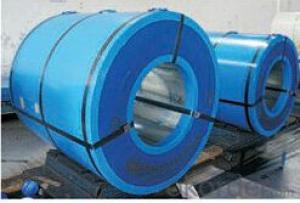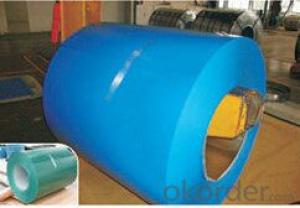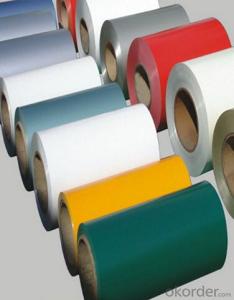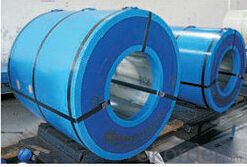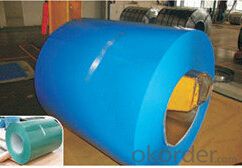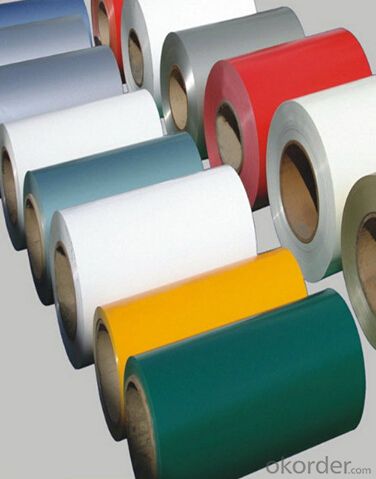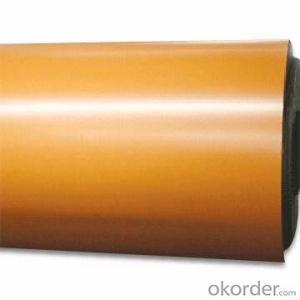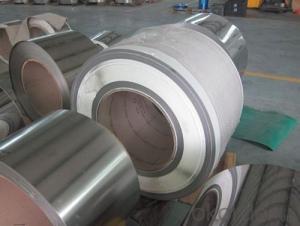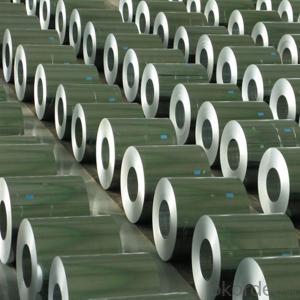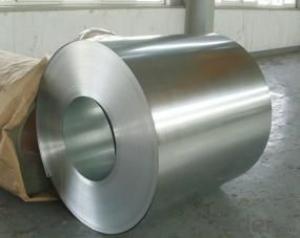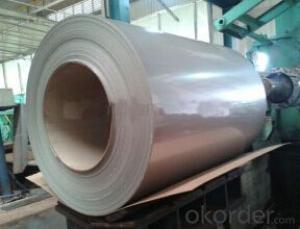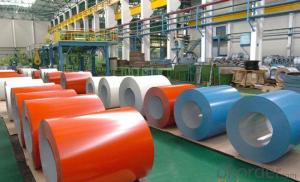Prepainted Steel Coil with Matt Finish for Constructions
- Loading Port:
- Shanghai
- Payment Terms:
- TT OR LC
- Min Order Qty:
- 25 m.t.
- Supply Capability:
- 10000 m.t./month
OKorder Service Pledge
OKorder Financial Service
You Might Also Like
Basic Info.
Model NO.:0.50*1000*C
Surface Treatment:Coated
Certification:ISO, SGS, BV, ISO9001:2008 &SGS
Technique:Cold Rolled
Standard:ASTM, JIS, GB, AISI, DIN, BS
Application:Sandwich Panels, Corrugated Steel Sheets
Edge:Slit edge
Stock:Not Stock
Steel Grade:CGCC & Cglcc
Thickness:0.16~1.20mm
Coil Width:600~1250mm
Coil ID:508/610 Mm
Color:Ral Color or as Customer′s Color Sample
Export Markets:Global
Additional Info.
Packing:Seaworthy, Standard Export Package, in Container
Standard:0.50*1000*C
Origin:China
HS Code:7210701000
Production Capacity:220, 000 Tons/Year
Details
Description:
1) Standard: JIS G3312 CGCC & CGLCC, equivalent to ASTM A755M, EN10169
2) Grade: CGCC and CGLCC
3) Hardness: Both soft and full hard are available
4) Surface finish: With or without protect film covered
5) Thickness range: 0.16-1.20mm
6) Coil width: 600-1250mm, general 914mm, 1000mm, 1220mm and 1250mm.
7) Shape: Both sheet and coil are available
8) Coating: Z40 to Z275, or AZ30 to AZ150
9) Paint thickness: Top 5 um + (10-20) um polyester, Reverse 5-10 um Epoxy
10) Color: any RAL code, or according to customer's sample
11) Coil weight: 3-6 tons, or according to customer's requirements
12) Max loading in one 20ft container: 25 tons generally
13) MOQ: 25 tons for each thickness or color;
14) Delivery time: 2 weeks or one month generally.
15) Applications: Widely used for roof tiles, outer walls, ovens, explosive-proof steel, electrically controlled cabinets, and industrial freezers in the residential and industrial buildings.
| Prepainted galvanized steel coil ( PPGI ) | Prepainted galvalume steel coil ( PPGL ) | |
| Standard | JIS G3312 CGCC ASTM A755M EN10169 | J IS G3322 CGLCC AS 1397 G2+AZ |
| Valid thickness | 0. 16 ~1. 2 0mm | 0. 16 ~1. 2 0mm |
| Coil width | 600~1250mm | 600~1250mm |
| Coil ID | 508mm & 610mm | 508mm & 610mm |
| Coil weight | 3~5 tons | 3~5 tons |
| Coating | 4 0~275 g/m2 | AZ30 to AZ150 |
| Paint t hickness , top side | 15~25 microns | 15~25 microns |
| P aint t hickness , reverse | 5~7 microns or 15~25 microns | 5~7 microns or 15~25 microns |
| Color | any RAL code | any RAL code |
| Package | vertical, eye to sky & horizontal | vertical, eye to sky & horizontal |
| MOQ | 25 tons | 25 tons |
- Q: I have a carbon steel file that I want to bend in a letter C shape. So, what is the malliable temperature? If it's low, could it be done in a camp fire?
- It's now not rather that rough. You can use your charcoal grill to do it. First construct a colossal fireplace in it after which bury the metal within the coals. It'll simplest take approximately ten minuites or so for the metal to warmth by way of. Then decide on it out of the coals with tongs and drop it right into a bucket of water. Repeat as preferred. Eventually it is going to get as brittle as glass. To repair this, you have got to anneal the steel. Again warmth the steel within the coals, simplest this time allow it keep there till the coals cross the entire manner out all by way of themselves. Next day while the entire manner cool, Take it out and blank it off. Viola!, you may have hardened metal.
- Q: Could someone please explain what happens when steel is heat treated and why these happenings cause the steel to become harder? Please dig down into the micro details of the crystallites but in somewhat laymen's terms. Also describe the processes which achieve these results; if you have the time. Thanks for your time and effort.
- If you are speaking of a micro mini skirt, then i would think that the answer would be 1000 Hostess HoHo's would equal a macro skirt.
- Q: What are the different methods of welding steel coils?
- There are several different methods of welding steel coils, each with its own advantages and applications. The most common methods used in welding steel coils include: 1. Resistance Welding: This method uses pressure and electric current to generate heat and join the steel coils together. It is commonly used for high-speed production and can be further categorized into spot welding, seam welding, and projection welding. 2. Arc Welding: This method involves creating an electric arc between an electrode and the steel coils, which generates intense heat and melts the metal. There are various types of arc welding techniques, such as shielded metal arc welding (SMAW), gas metal arc welding (GMAW), and flux-cored arc welding (FCAW). 3. Laser Welding: Laser welding utilizes a highly focused laser beam to melt and join the steel coils together. This method offers precise control, high welding speeds, and minimal heat-affected zones, making it suitable for thin materials and intricate designs. 4. Electron Beam Welding: This technique employs a concentrated beam of high-velocity electrons to melt and fuse the steel coils. It is commonly used for welding stainless steel and other high-temperature alloys, as it provides deep penetration and minimal distortion. 5. Friction Stir Welding: In this method, a rotating tool with a pin is plunged into the steel coils, creating heat through friction. The softened material is then stirred together to form a solid joint. It is commonly used for joining aluminum, but can also be applied to steel coils. 6. Ultrasonic Welding: Ultrasonic welding involves applying high-frequency vibrations to the steel coils, which creates friction and generates heat to fuse the materials together. This method is commonly used for smaller steel coils and can provide fast and efficient welding with minimal distortion. These are some of the different methods of welding steel coils, each offering unique advantages and suitable for specific applications. The choice of welding method depends on factors such as the type and thickness of the steel, desired strength and quality of the weld, production speed, and cost considerations.
- Q: How are steel coils used in the production of electrical wiring?
- Steel coils are used in the production of electrical wiring as a core material for the conductors. The steel coils are typically shaped into a cylindrical form and coated with an insulating material. This helps in providing structural support to the wiring and also enhances its conductivity and durability.
- Q: How are steel coils cut into smaller sizes?
- Steel coils can be cut into smaller sizes using various methods, depending on the desired dimensions and quantities. One common method is called slitting, which involves passing the coil through a set of circular blades. These blades make multiple cuts simultaneously, creating narrower strips of steel. Slitting is often used to produce narrow coils or strips for specific applications such as automotive parts or electrical components. Another method is called shearing, which involves using a straight blade to cut the coil into smaller lengths. This method is typically used when precise dimensions are required, such as for manufacturing flat sheets or plates. Shearing can be done manually or using automated machinery. Additionally, some steel coils can be cut using laser or plasma cutting techniques. These methods allow for more flexibility in terms of shape and size, as they can create intricate cuts or contours. Laser or plasma cutting is commonly used when specific shapes or profiles are needed for applications like construction or fabrication. Overall, the process of cutting steel coils into smaller sizes involves various techniques such as slitting, shearing, laser cutting, or plasma cutting. The choice of method depends on factors such as the desired dimensions, quantities, and specific requirements of the end product.
- Q: What are the different grades of steel used in coils?
- There are several different grades of steel used in coils, including low carbon steel, medium carbon steel, high carbon steel, and alloy steel. Each grade has specific properties and characteristics that make it suitable for various applications, such as automotive, construction, or manufacturing industries. The grade of steel chosen for coil production depends on factors such as strength requirements, formability, corrosion resistance, and cost considerations.
- Q: How are steel coils used in the manufacturing of safety systems?
- Steel coils are commonly used in the manufacturing of safety systems such as airbags and seat belts. The steel coils are formed into springs which provide the necessary tension and force to ensure the proper functioning of these safety devices. The coils are carefully designed and integrated into the system to enhance its performance and reliability, ultimately helping to protect occupants in the event of a collision.
- Q: What are the safety precautions to be followed while handling steel coils?
- To prevent accidents and injuries when dealing with steel coils, it is crucial to adhere to specific safety measures. Here are some safety measures that must be observed: 1. Personal Protective Equipment (PPE): Always wear suitable PPE, including safety glasses, gloves, steel-toed boots, and hard hats. These items serve to shield you from potential dangers such as falling objects, sharp edges, and chemicals. 2. Proper Lifting Techniques: Employ correct lifting techniques to avoid strains and back injuries. Lift using your legs, not your back, and refrain from making sudden or twisting movements while handling the coils. If the coils are excessively heavy or cumbersome to lift manually, resort to mechanical lifting equipment such as forklifts or cranes. 3. Secure Storage: Ensure that steel coils are stored securely and stably to prevent them from falling or rolling over. Make use of appropriate racks, shelves, or storage containers specifically designed for steel coils. Keep the storage area clean, organized, and devoid of obstructions. 4. Handling Tools: Utilize appropriate handling tools like coil hooks, lifting clamps, or coil tongs to firmly grasp the steel coils. Avoid using makeshift or improper tools, as they can cause the coils to slip, leading to accidents. 5. Secure Transportation: Prior to transporting steel coils, ensure that they are adequately secured on the truck or flatbed. Utilize suitable tie-downs, straps, or chains to prevent the coils from shifting or falling during transit. Adhere to all transportation regulations and guidelines to ensure safe transportation. 6. Awareness of Surroundings: Maintain awareness of your surroundings and the presence of other workers or equipment in the vicinity. Keep a safe distance from moving machinery, forklifts, or other vehicles to avoid collisions or accidents. 7. Hazard Communication: Train all employees handling steel coils on proper safety procedures and ensure that they comprehend the potential hazards involved. Display safety signs or labels to indicate the presence of heavy loads or hazardous materials. 8. Regular Maintenance: Regularly inspect and maintain equipment such as lifting devices or storage racks to ensure they are in proper working condition. Promptly report any defects or malfunctions to the relevant personnel for repairs. By adhering to these safety precautions, the risk of accidents, injuries, and damage when handling steel coils can be minimized. Prioritizing safety in the workplace is crucial to safeguarding yourself and your colleagues.
- Q: What are the main raw materials used in making steel coils?
- The main raw materials used in making steel coils are iron ore, coal, and limestone.
- Q: is there a type of steel that is stronger or does the rail represent the top of the line?
- consumer-friendly steel is used however the rails are tempered to cause them to stand up to the pounding they get from the practice wheels,the intense velocity trains utilized in Europe are made up of a greater variety of steel in accordance to organization who makes them in Germany ,i think of it replaced into Krupp's of Germany who cause them to
Send your message to us
Prepainted Steel Coil with Matt Finish for Constructions
- Loading Port:
- Shanghai
- Payment Terms:
- TT OR LC
- Min Order Qty:
- 25 m.t.
- Supply Capability:
- 10000 m.t./month
OKorder Service Pledge
OKorder Financial Service
Similar products
Hot products
Hot Searches
Related keywords
